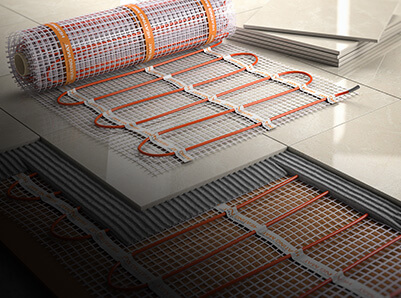Underfloor heating has become increasingly popular in modern homes and renovation projects, providing invisible warmth that’s efficient and evenly distributed throughout a room. Along with this increase in demand, there has also been a debate about whether to opt for water or electric underfloor heating. In this guide, we’ll be looking at the two different variations, helping you make an informed decision when it comes to water vs electric underfloor heating.

What is Underfloor Heating?
Before we get into the details of all the differences between water and electric underfloor heating, let’s make sure we’re clear about what underfloor heating actually is. Underfloor heating works by circulating heat beneath your floor, creating a luxurious, cosy feeling. Take a look at our full range of underfloor heaters to find your perfect underfloor heating solution.
Underfloor Heating Benefits
- More energy efficient than radiators
- Luxurious heating underfoot
- Even heating across the whole room/space
- More wall space (no need for radiators!)
What is Water/Wet Underfloor Heating?
In water underfloor heating systems, heat is distributed around the house via thin pipes laid under the floor. These pipes carry hot water around the home, releasing heat from below your flooring, creating a cosy atmosphere. The water is heated in the main boiler of the home, and the temperature can be controlled on a thermostat.
In cases where the boiler supplying hot water for the household is gas powered (as is the case in most UK households), this type of heating system is known as wet underfloor heating. Wet underfloor heating systems involve a bulky network of pipes running through the house, so they can only be fitted in homes where there is sufficient space under the floor to accommodate the pipework. Although allocating this space is not a problem in new builds, electric underfloor heating is often a more feasible option in existing properties.
Water/Wet Underfloor Heating Benefits
- Perfect for larger spaces or whole-house renovations
- More energy efficient for larger spaces
- Compatible with renewable energy sources
What is Electric Underfloor Heating?
An electric underfloor heating system uses electric wires fitted beneath the floor to provide heat. When an electric current is passed through the wires, they become hot and that heat is transferred through the floor to the room above.
Electric underfloor heating is easier to fit than wet underfloor heating, and t. The installation costs of an electric system are therefore lower. Because there are fewer spatial requirements for installing an electric underfloor heating system, they are often a more feasible option in existing properties.
Electric Underfloor Heating Benefits
- Perfect for retrofit projects
- Quick and easy to install
- Good for small areas
Water vs Electric Underfloor Heating: Key Differences
Installation Process
Electric underfloor heaters are far easier to install than water underfloor heaters due to the nature of how they operate. If you’re looking for a DIY job rather than a full project, consider opting for an electric underfloor heater.
Running Costs
If you’re happy with a bigger installation project and are looking for something more cost-efficient in the long run, a water/wet underfloor heater would be a better choice, as electric ones are more expensive to run long term.
Floor Height and Build Up
Underfloor water heaters require more depth under your floor, something which will need to be taken into consideration. This means that water heater systems are often a great choice for new builds, as this can be accommodated for in the building process. Electric underfloor heaters don’t need as much floor height, so they’re a great choice for older and period properties.
Maintenance
Water underfloor heaters are more durable, but in the long run will need more maintenance, which can be expensive. Electric underfloor heaters, on the other hand, require little to no maintenance, but can have a shorter lifespan.
Choosing the Right System for Your Home
Choosing between a water and an electric underfloor heating system depends on a few key things, from your home's layout and heating needs, to your budget and renovation plans. Each system offers luxurious underfoot warmth, but they perform best in different situations. Need help picking the right one? Our team is here to help you find your perfect system, whether you opt for water or electric underfloor heating.







Comment